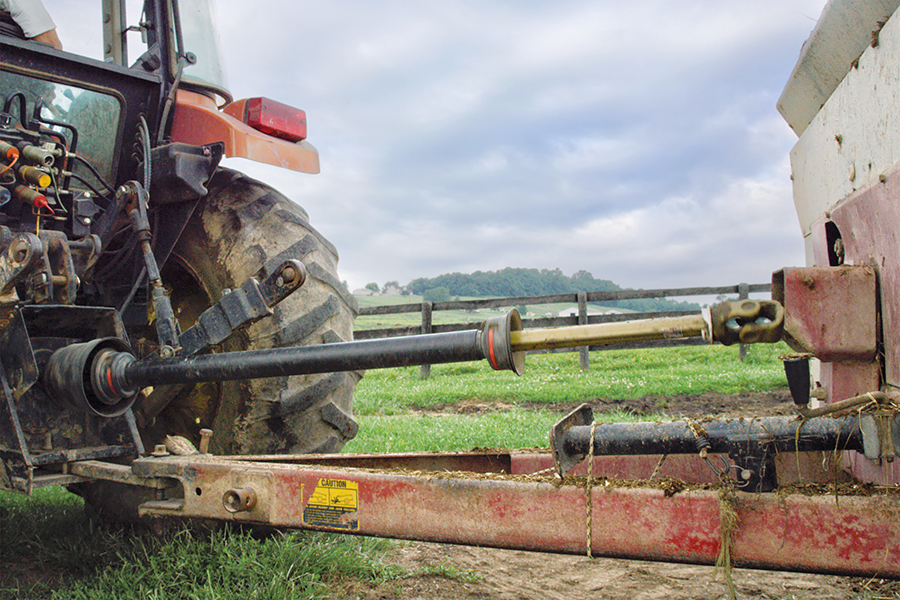How to minimise the risks from PTO shafts
27th August 2024
Accidents involving PTO shafts are among the most common causes of serious injuries when operating farm machinery.

Every year people are killed or seriously injured in accidents involving PTOs and PTO drive shafts. Most of these accidents are preventable if the PTO and PTO drive shaft are fitted with guards of good design which are properly used and maintained, the Health & Safety Executive (HSE) says.
With a tractor transmitting nearly all of its horsepower into the PTO shaft, if an entanglement occurs, it can wrap an arm or leg around it nine times in less than a second, Kramp UK OEM specialist, Adam Hubbard warns.
Start with the tractor
The most crucial part of PTO safety is that you start with the tractor, Adam continues. Ensure it is made safe, the handbrake is fully on, put all controls and gears in neutral, stop the engine and remove the key before working on a PTO. Most accidents involving PTOs happen because these steps are not followed. But it does not totally eliminate the risk even when they are.
“It’s best to maintain a PTO before and after it is last used, before taking a break, or at the end of the day. A quick visual check of the guard and the chain, and that it is sufficiently greased may be all that is needed most of the time. Also, check the PTO guard is secure to the PTO.”
Adam has a tip for the PTO guard chain, which takes just 20 seconds and will save you time and money – but most farmers don’t do it. “When hooking up the chain, double it back through the D-link and hook it onto itself. This will shorten the chain length and prevent it from being wrapped around the guard tube. The guard should then only be able to turn 90 degrees with the available slack on the chain. A little more slack in the chain may be needed for a wide angle application, but if it is too much, it will wrap around the shaft and eventually wear through it, requiring replacement,” he explains.
Correct set up
The most common cause of PTO failure is an insufficient overlap of the PTO profile tubes. This causes excessive vibrations when the PTO is in operation, producing a whipping motion, which adds stress to the universal joint. The heat generated can cause a catastrophic failure, endangering passers-by, Adam warns. The overlap should be less than 33% longer than the shaft length. In practice, a closed shaft measuring 1,000mm should have a working length of less than 1,330mm. Adam recommends that the maximum closed centre length is at most 1,410mm due to vibration.
He also urges farmers to refrain from using PTO adaptors on the main drive and to limit the maximum power they transmit to less than 30kW. Instead, to be safe, change the yoke on the PTO to be suitable for the implements it needs to operate.
Regulations to be aware of
Farmers should also be aware of regulation EN12965, which came into force shortly before Brexit and was copied into UK law. Only collar locks are allowed on the primary drive shaft connected to the tractor. This means push-pin or certain collar locks with exposed springs are prohibited on new machines. If a new machine is delivered, Adam recommends checking the compliance of the PTO connection.
Additionally, it’s a statutory requirement for the PTO guard to overlap the joint by a minimum of 50mm when in a straight position, ensuring the guard covers the moving parts.
All new operators using a tractor powering a PTO must be fully briefed on PTO safety, Adam adds. More experienced operators should also be wary of complacency and treat a PTO seriously and with their full attention.
Kramp supports its dealers with bespoke training courses including PTO safety and can offer these to farmers on request.
HSE’s advice for PTO shaft guards
Check that the guard is:
- Made to a recognised standard such as BS EN ISO 5674
- The correct size and length for the shaft, both when closed and when extended
- A non-rotating type, with the restraining device (for example, securing chains) in place
- Properly used and maintained. Clean and lubricate guards regularly
- Supported when not connected. Do not rest it on the drawbar or drop it on the ground, and do not suspend it by the restraining device
- Safe from damage, for example, by livestock, when the machine is in store.
- Make sure no one uses adaptors to allow a 21 spline 1,000 rpm shaft to drive a six spline 540rpm shaft.
Read more Farm business news


